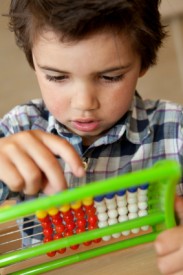
Something very interesting happens in the brains of young children when they reach age four, or thereabouts. They start to understand “how many” items are in a set—and in particular, they begin to be able to differentiate sets of “four” items or more. This ability signals that they have discovered “the cardinal principle,” the idea that the last number reached when counting the items in a set represents the entire set.
Of the many challenging concepts that preschoolers need to master for kindergarten math readiness, the cardinal principle is one of the harder ones, and it takes about a year to develop. It is a major milestone in a child’s mathematical development, after which the child is able to demonstrate a good understanding of “how many” in a variety of ways, such as matching sets of unlike items when the number of items in each set is the same.
Most parents believe that their child’s mathematical skills are developed largely by formal schooling, but research indicates that certain kinds of parent-child interactions in the preschool years, commonly referred to as “number talk,” are a primary driver of children’s mathematical ability through at least 5 thgrade. Number talk includes activities such as rote counting (counting “one, two, three, four,” as when playing hide and seek), counting tangible objects such as Cheerios (“one, two, three, four Cheerios”), and labeling the number of items in a set (“there are four Cheerios”).
As with verbal literacy, there is wide variation in the math knowledge of four year olds, with a one to two year gap between children who are more mathematically advanced and their less advanced peers. Children with more exposure to number talk, and specifically to number talk about sets of four or more items, catch on to the cardinal principle faster than those who engage in less number talk or in number talk that focuses mostly on smaller sets of one to three items.
Unfortunately, few parents are informed about how kindergarten math readiness develops, and they tend not to know which math skills are developmentally appropriate for their child in the preschool years. For example, parents often do not realize that their young child, who can easily count to 10, may not be able to identify a group of 10 objects. Parents also tend to spend more time engaged in number talk around smaller sets of one to three items instead of larger sets of four and more, while the opposite has been shown to be more beneficial.
Strategies to Improve Math Readiness
There are simple things that parents and caregivers can do to help preschoolers learn about numbers and prepare for kindergarten math:
- Ask children to count objects they can touch, such as Cheerios, pieces of cheese, or blocks, and objects they can see, like pictures of dogs on a page of the book Go, Dog. Go!
- Label the number of items in sets of objects children use throughout the day. For example, “You have six crayons.”
- When counting tangible objects, label the number of items in the set, too, to point children toward the crux of the cardinal principle—that the last number counted represents the entire set of objects. For example, “one, two, three, four crackers; you have four crackers.”
- Talk about larger sets more often. What children learn about larger sets helps them perform better on tasks involving smaller sets as well.
- Expose children to age-appropriate, educational math games for preschoolers.
Perhaps one day in the not-too-distant future, public awareness of the importance of building preschool math literacy will match that of building preschool verbal literacy. But for now, parents and caregivers who are in the know can begin to engage preschoolers with the right kinds of activities to give them an edge in developing the early childhood math skills needed for success throughout the elementary grades.
I encourage you to try the some of the tips outlined above if you have young children of your own and to share this article with other parents of preschool-age kids, as we work together to raise our children’s opportunities for future success.
For further reading:
Gunderson, E. A., Levine, S. C., Some types of parent number talk count more than others: relations between parents’ input and children’s cardinal-number knowledge. Developmental science. 14:5 (2011), pp 1021–1032.
Related Reading:
Still the Write Stuff: Why We Must Continue Teaching Handwriting

